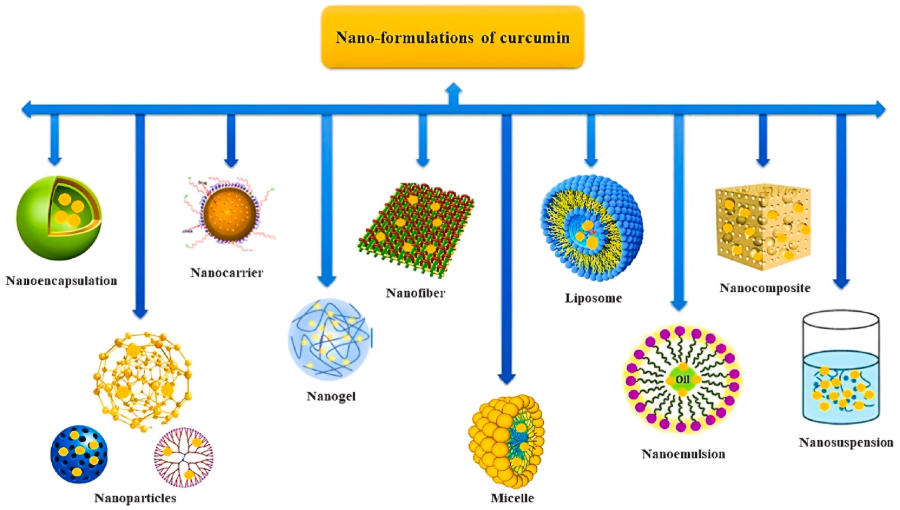Curcumin Nanomedicine: A threat to cancer growth
Cancer and side effects:
Noncommunicable diseases are influencing individuals of all age groups, areas, and countries. Although, it does not spread person to person directly, every 6 out of 10 people’s deaths in India are caused by non-communicable diseases that include heart attacks, strokes, cancers, and diabetes. Scientists in many pharmaceutical companies have been interested in the development of new formulations with the available drugs and discovering new anticancer drugs of various molecules that shouldn’t have any significant side effects. Remarkably, anticancer drugs are associated with side effects that include but are not limited to myocardial ischemia, angina, anemia, dizziness, thrombophlebitis, diarrhea, and gastrointestinal bleeding.
A drug without significant side effects!
Curcumin, a natural compound, has not shown any side effects after several clinical trials on humans and is clinically beneficial for patients with colorectal cancer and pancreatic cancer. Natural curcumin has been extracted from the plant turmeric (Curcuma longa). The turmeric root has been used for centuries in Asia as both a spice and a medicinal herb. Curcumin is, chemically, a polyphenolic compound and exhibits anticancer properties in addition to antimicrobial, antidiabetic, antiseptic, antioxidant, and anti-inflammatory properties. Modern research efforts are engaged in the direction of the progress of curcumin-based drug delivery systems for anticancer drugs because of their lower toxicity or side effects, and prevention of developing cancer. Even though Curcumin has many merits, it has potential challenges to use as medicine directly because of its extremely low bioavailability (<1%), low water solubility (0.5 mg/ml), hydrophobic in nature, rapid metabolism, and photodegradation, and chemical instability.
Nanocurcumin- an organic nanoparticle:
The nanoformulations are the most important method to overcome those issues associated with bulk curcumin to be a potential anticancer drug. Nanocurcumin is a type of organic nanoparticle, that enables more aqueous solubility and enhances biological activities with more effective surface area, bioavailability, long-term stability, and transmembrane permeability. Nanocurcumin enables beneficial anti-cancer activity against colorectal cancer in small amounts whereas bulk curcumin (0.5-8 g) requires the administration of higher doses to get anti-cancer activity. Hence, this synthesis of nanoparticles increases the bioavailability and benefits of curcumin efficiently. For instance, the antimicrobial activity of nano curcumin is 40% more effective than curcumin in its original form even after storage for one month.
Development of nano-formulation-based drug delivery system:
The development of a drug delivery system and design plays a vital role in delivering the drug to the target site more accurately without affecting the normal healthy cells. The drug delivery follows one or a combination of the following mechanisms (pH, heat, time, pulsation, and decomposition by light and heat). Hence, the released drug in the body has been identified based on the conditions existing in the body. The solubility of the drug, permeability, encapsulation material, and thickness influence the drug-releasing kinetics.
Curcumin-based nanoformulations:
Recently, Curcumin has been engineered as nanoparticles, nanocarriers (curcumin loaded into polymer), nano gels, nanofibers, micelles, liposomes, nanocomposite, nanosuspension, nanoencapsulation, and nanoemulsions as shown in Figure 1. The chemical bonds involved in nanoformulations determine the cytotoxic activities, stability of the drug, and physicochemical properties for cancer treatment. Here, the nanocurumin has greater solubility than bulk curcumin and increased solubility plays a significant role in the drug efficiency. Hence, curcumin nanoparticles are synthesized and stabilized by adding polymers (PLGA, pectin-chitosan), silica nanoparticles, and some metal nanoparticles (gold nanoparticles) along with curcumin. Curcumin-based micelles are a huge challenge to design and they can be effectively useful for a high drug accumulation with increased permeability and retention effect by polymeric micelles so that enhanced anticancer efficiency has been realized.
Multiphase solid nanocomposite has less than 100 nm-sized material made of polymerization and mineral matrix. The reduced graphene oxide-curcumin nanocomposite has shown anticancer activity against the SW-948 and HT-29 Cell lines. A liposomal core-shell nanocarrier, submicron level (<500 nm), is designed to deliver the curcumin in a controlled manner with the help of sodium alginate and silk fibroin. Its resulting anti-cancer activity enables nanoparticles as a next-generation cancer treatment. Nanogels are biodegradable cross-swelling polymer nanocarriers for highly efficient drug transport in a sustained manner. Curcumin-loaded nano gels reduce tumor weight and volume significantly. Nanofibers, a few nm to 1000 nm diameter, have been used to modify the kinetics of drug release. Generally, these fibers are synthesized by electrospun methods and they show enhanced antiproliferative effects against HT-29 colon cancer cells.
Hence, the curcumin nanoformulation design exhibits excellent properties that include and are not limited to specific targeting, increasing the bioavailability and decreasing the side effects.
United States Food and Drug Administration (FDA) permitted the efficiency and safety of curcumin. Hence, curcumin was found to be a benign and good anticancer beneficial activity within the suggested dose. It is reported that 12g/day has not produced significant toxicity during human clinical trials. The side effects that can be tolerated by humans have been identified at high doses of curcumin such as headaches, gastrointestinal disturbances, and skin rashes. The futuristic research on nanoformulation to overcome complex manufacturing processes and high production costs will deliver effective cancer prevention and management devices.
The diagnostic tools at various stages of cancer should be safe, cost-effective, easy to operate, quickly processable, and reliable with a highly acceptable rate to the population of the globe. Education and awareness about cancer and its earlier stage of detection can significantly improve the high success rate of treatment and the lower economic burden. Although curcumin nanoformulation-based anticancer drugs have been investigated in various stages of treatments, the earlier detection and awareness of cancer will be one of the best ways to create a healthier individual as well as society.
Source

